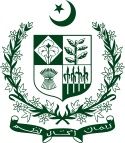Local government in Pakistan
Pakistan |
|---|
 |
This article is part of a series on the politics and government of Pakistan |
Constitution
|
Government
Parliament
Executive:
Judiciary
|
Elections
|
Administrative units
|
Federalism
|
Foreign relations
|
|
Pakistan is a federal republic with three tiers of government: national, provincial and local. Local government is protected by the constitution in Articles 32 and 140-A, and each province also has its own local-government-enabling legislation and ministries responsible for implementation. District councils and metropolitan corporations are respectively the highest rural and urban tiers of local government in the provinces. Both urban and rural local government have two or three tiers in all provinces except Khyber Pakhtunkhwa, where councils are not identified as either urban or rural. There are 129 district councils across the four provinces, 619 urban councils made up of one city district, four metropolitan corporations, 13 municipal corporations, 96 municipal committees, 148 town councils, 360 urban union committees, and 1,925 rural councils. Additionally there are 3339 neighbourhood, ‘tehsil’ and village councils in Khyber Pakhtunkhwa.[1]
Contents
1 Legislation
2 Levels
2.1 District
2.2 Tehsil
2.3 Union Council
3 References
4 External links
Legislation
In response to the failure of central/provincial governments to account for local preferences, the National Reconstruction Bureau (NRB) designed a local government system which was presented in the blue print "Devolution Plan 2000". Consequently, a new local government system was implemented on August 14th 2001, after each of the four provinces passed the Local Government Ordinance, 2001.[2]
Levels
Country (e.g. Pakistan) | |||||||||||||||||
Province (e.g. Punjab) | |||||||||||||||||
Division (e.g. Rawalpindi Division) | |||||||||||||||||
District (e.g. Jhelum District) | |||||||||||||||||
Tehsil (e.g. Sohawa) | |||||||||||||||||
Union Council (e.g. Domeli) | |||||||||||||||||
District
A district (Urdu: ضلع, zillah) is the first tier of local government. In total there are 149 districts in Pakistan, of which several are city districts. A District Government or a City District Government and Zillah Council form the governing body, with the District Coordination Officer serving as the administrative head.[3] The District Governor or Zila Nazim used to be the executive head of districts until 2010, when the government shifted power to the District Coordination Officers. Their role is similar to district governors, with responsibility for implementing government strategy and developing initiatives arising out of it.[4]
Tehsil
Among the three tiers of local government, Tesil government is second tier of it. It is where the functions, responsibilities and authorities of districts government is divided into more smaller units, these units are known as "Tehsil". The Tehsils are used in all over the Pakistan except Sindh province where the word "Taluka" is used instead, although the functions and authorities are same. The head of the Tehsil government is "Tehsil Nazim" who is assisted by the tehsil Naib-Nazim. Every tehsil has a Tehsil Municipal Administration, consisting of a Tehsil council, Tehsil Nazim, tehsil/taluka municipal officer(TMO), Chief officer and other officials of local council.[citation needed]
Union Council
Members of Union Council including Union Administrator and Vice Union Administrator are elected through direct elections based on adult franchise and on the basis of joint electorate. However, for the election to the reserved seats for Women in Zila Council proportionately divided among Tehsils or Towns shall be all members of the Union Councils in a Tehsil or Town. It is the responsibility of the Chief Election Commissioner to organize and conduct these elections.
References
^ "The Local Government System in Pakistan" (PDF). Commonwealth Local Government Forum. Retrieved 1 August 2018..mw-parser-output cite.citation{font-style:inherit}.mw-parser-output q{quotes:"""""""'""'"}.mw-parser-output code.cs1-code{color:inherit;background:inherit;border:inherit;padding:inherit}.mw-parser-output .cs1-lock-free a{background:url("//upload.wikimedia.org/wikipedia/commons/thumb/6/65/Lock-green.svg/9px-Lock-green.svg.png")no-repeat;background-position:right .1em center}.mw-parser-output .cs1-lock-limited a,.mw-parser-output .cs1-lock-registration a{background:url("//upload.wikimedia.org/wikipedia/commons/thumb/d/d6/Lock-gray-alt-2.svg/9px-Lock-gray-alt-2.svg.png")no-repeat;background-position:right .1em center}.mw-parser-output .cs1-lock-subscription a{background:url("//upload.wikimedia.org/wikipedia/commons/thumb/a/aa/Lock-red-alt-2.svg/9px-Lock-red-alt-2.svg.png")no-repeat;background-position:right .1em center}.mw-parser-output .cs1-subscription,.mw-parser-output .cs1-registration{color:#555}.mw-parser-output .cs1-subscription span,.mw-parser-output .cs1-registration span{border-bottom:1px dotted;cursor:help}.mw-parser-output .cs1-hidden-error{display:none;font-size:100%}.mw-parser-output .cs1-visible-error{font-size:100%}.mw-parser-output .cs1-subscription,.mw-parser-output .cs1-registration,.mw-parser-output .cs1-format{font-size:95%}.mw-parser-output .cs1-kern-left,.mw-parser-output .cs1-kern-wl-left{padding-left:0.2em}.mw-parser-output .cs1-kern-right,.mw-parser-output .cs1-kern-wl-right{padding-right:0.2em}
^ Anjum, Zulqarnain Hussain (Winter 2001). "New Local Government System: A Step Towards Community Empowerment?" (PDF). The Pakistan Development Review. 40 (4 Part II): 845–867. Retrieved 2018-05-23.
^ DCO job description Archived 2013-04-30 at the Wayback Machine.
^ Zila Nazim job description Archived 2007-07-04 at the Wayback Machine.
External links
- Government of Pakistan: Local Government overview
This article about government in Pakistan is a stub. You can help Wikipedia by expanding it. |